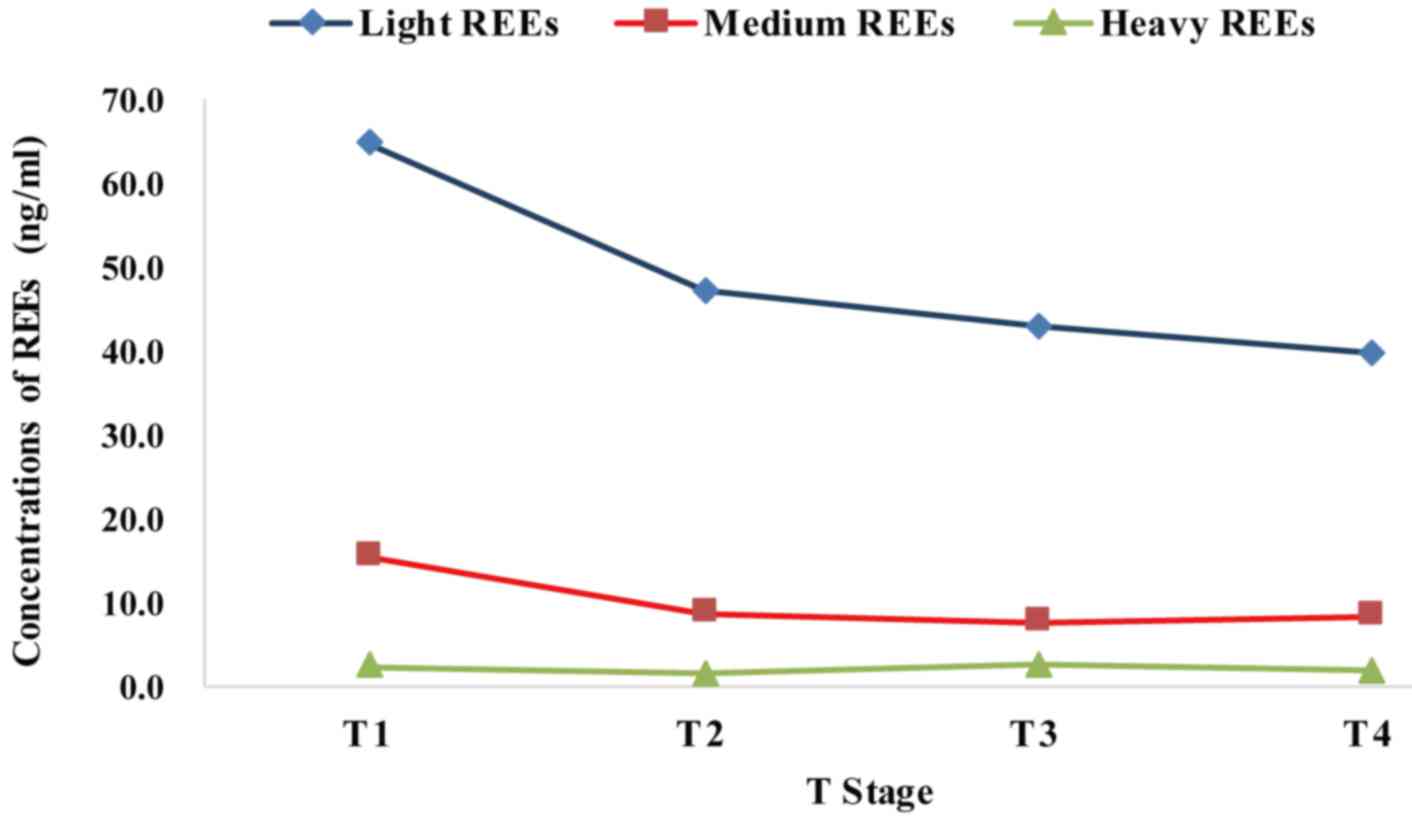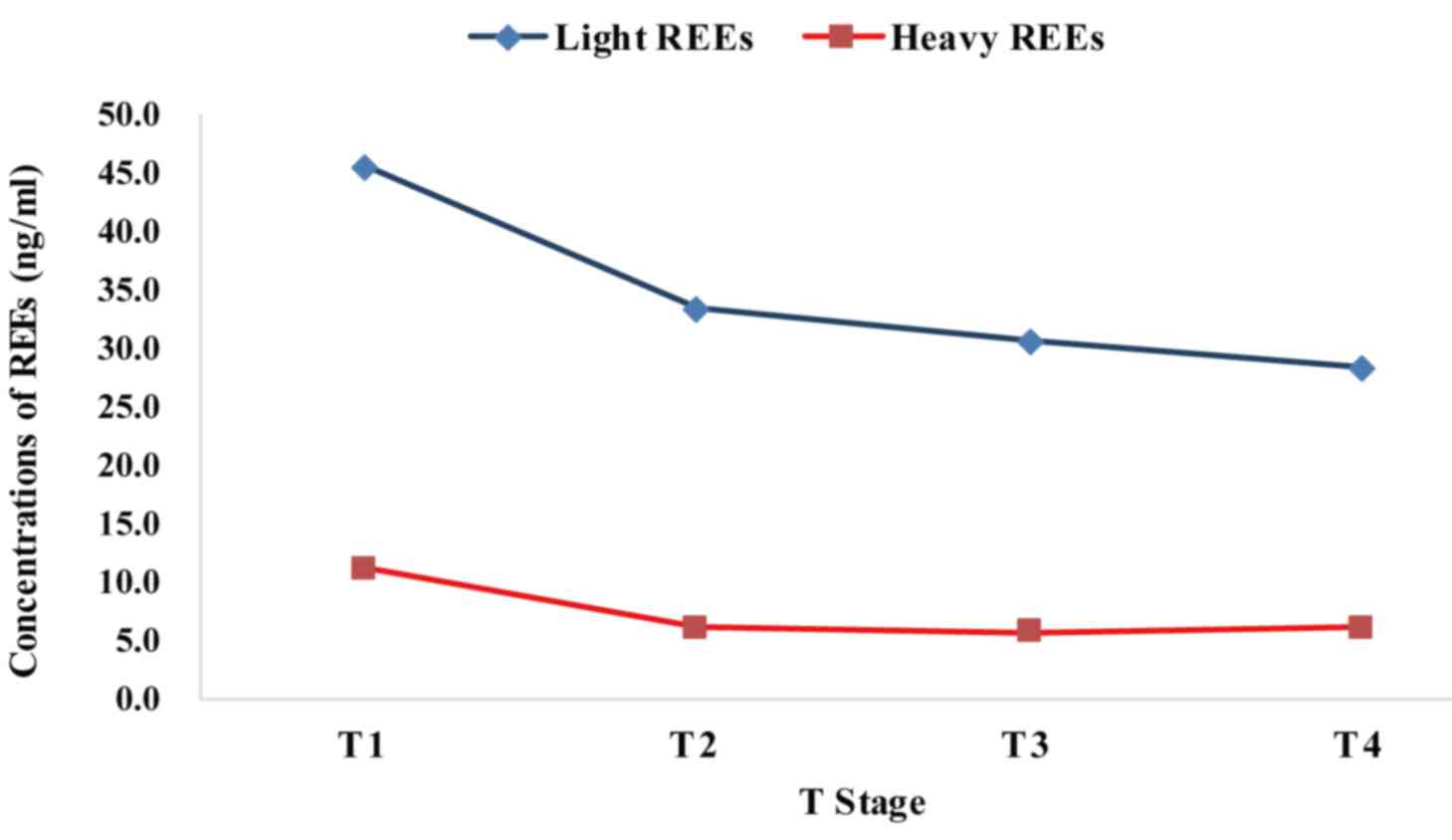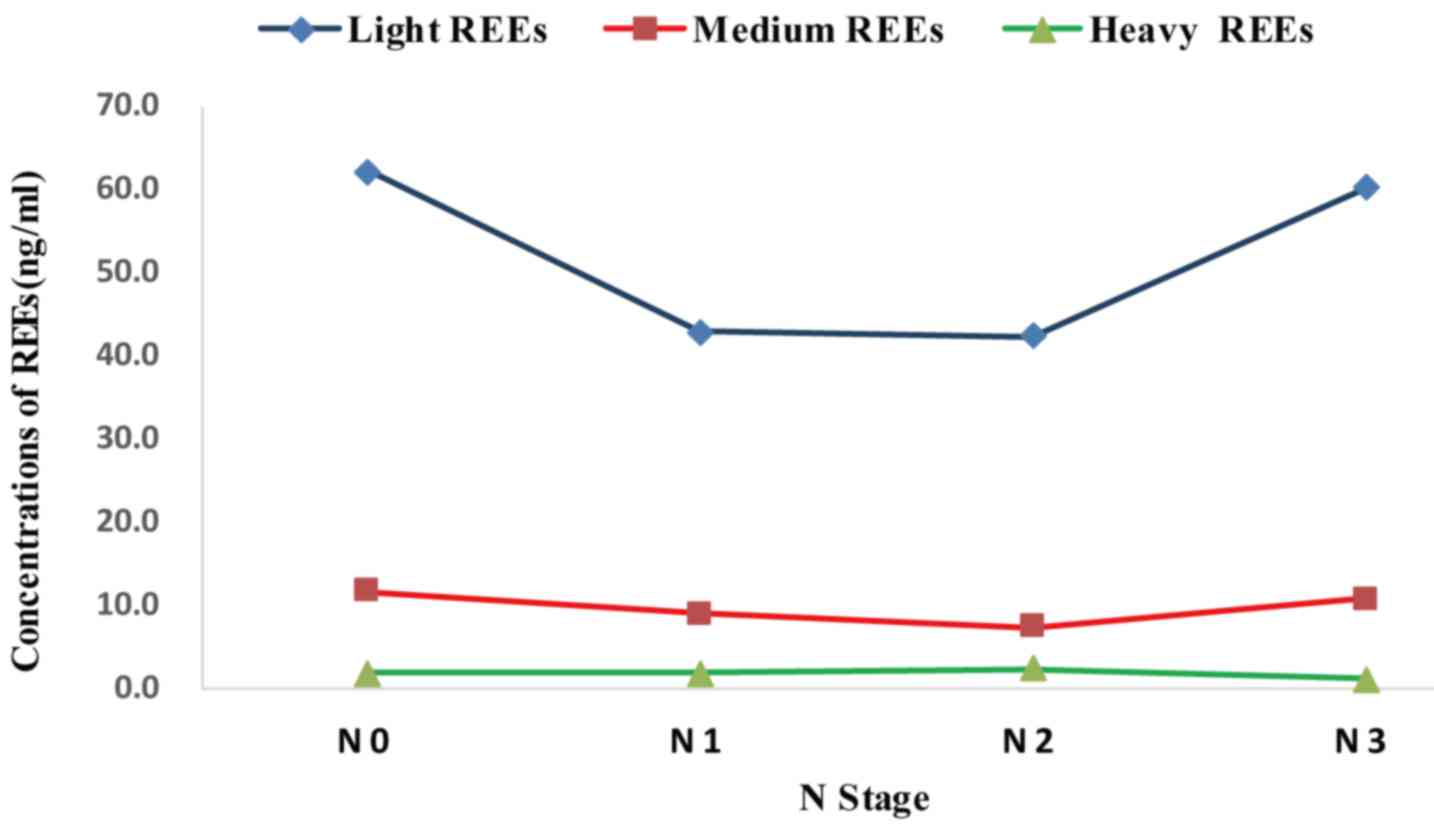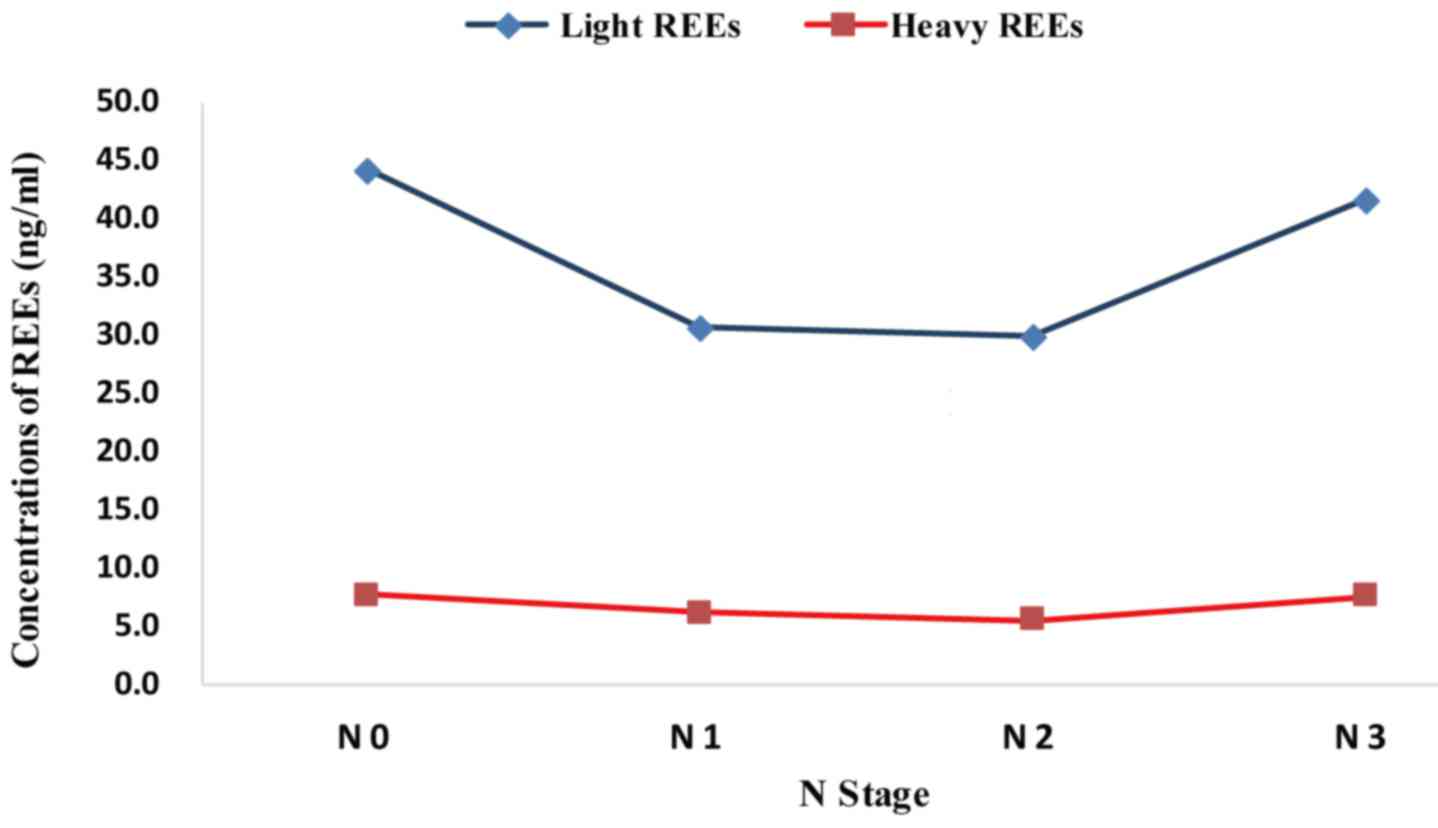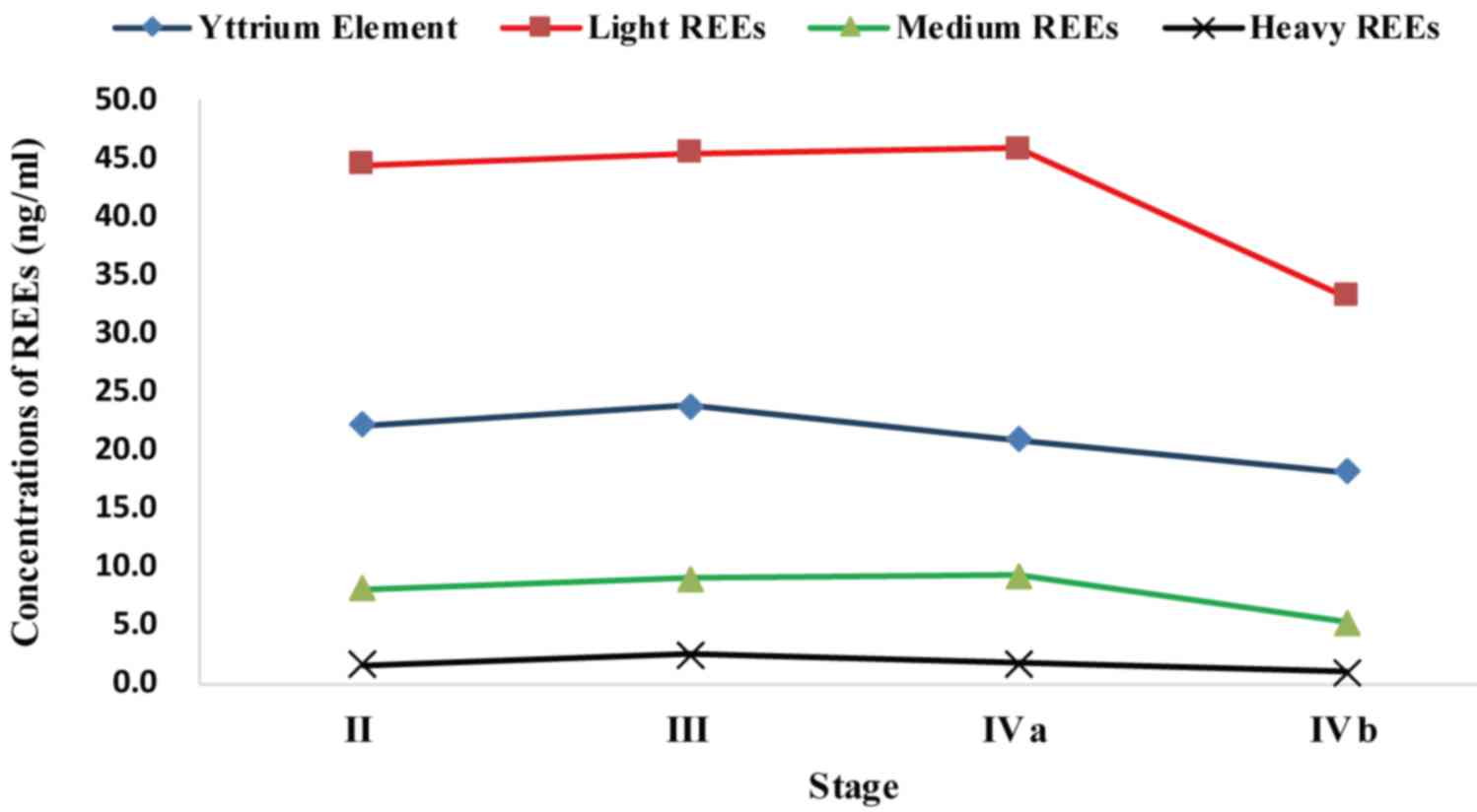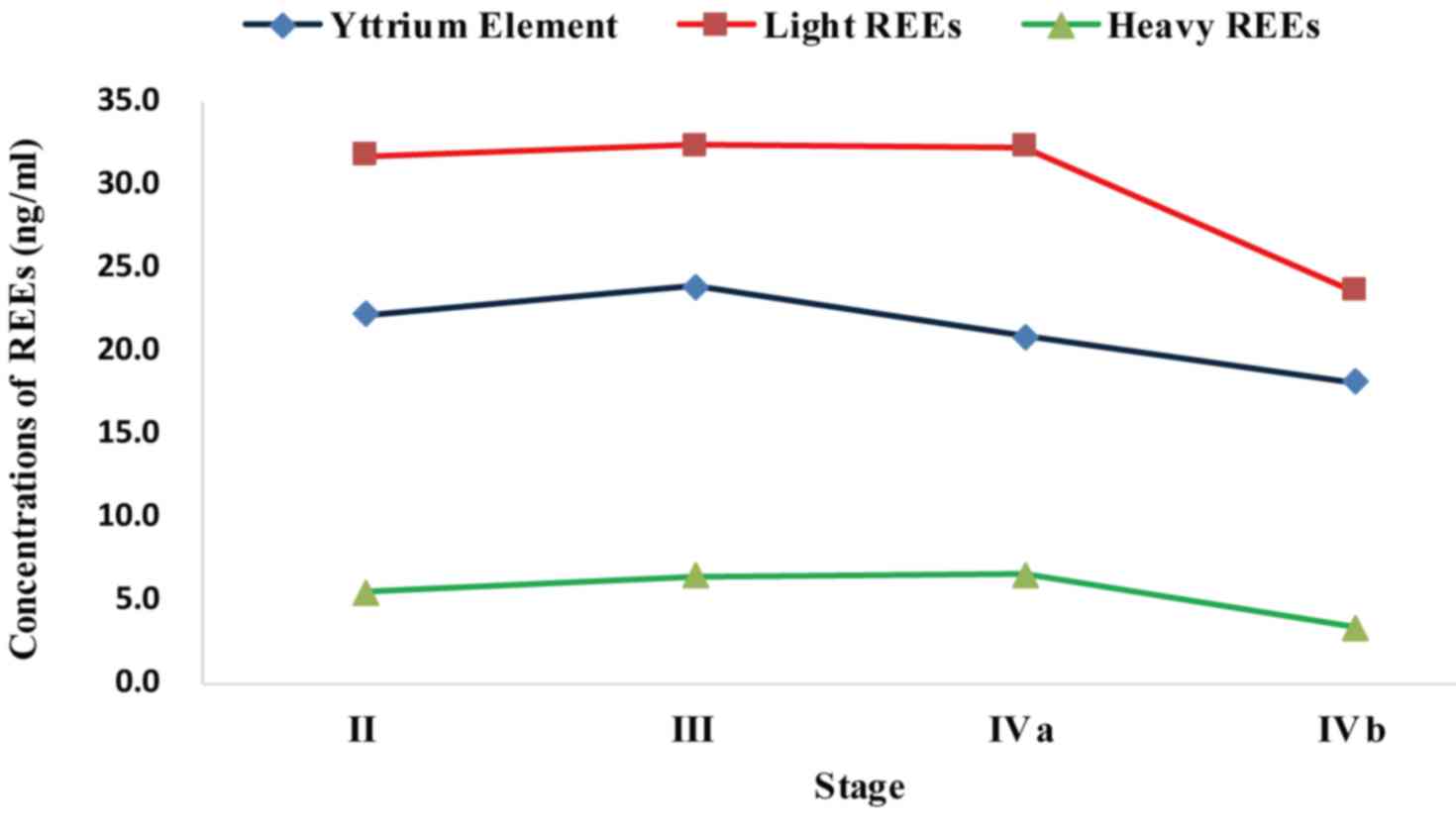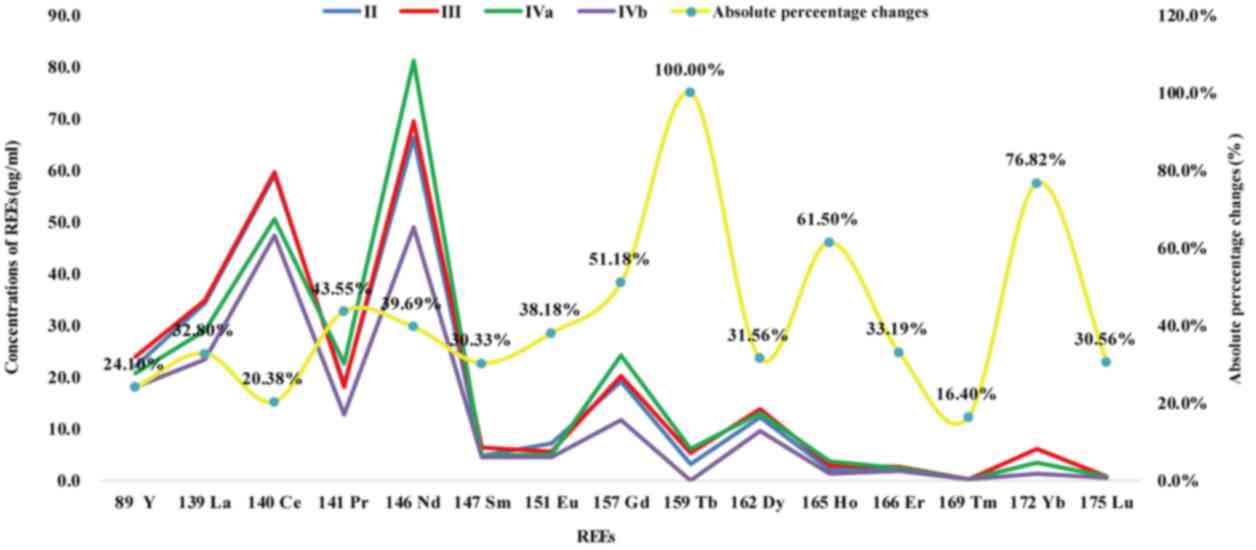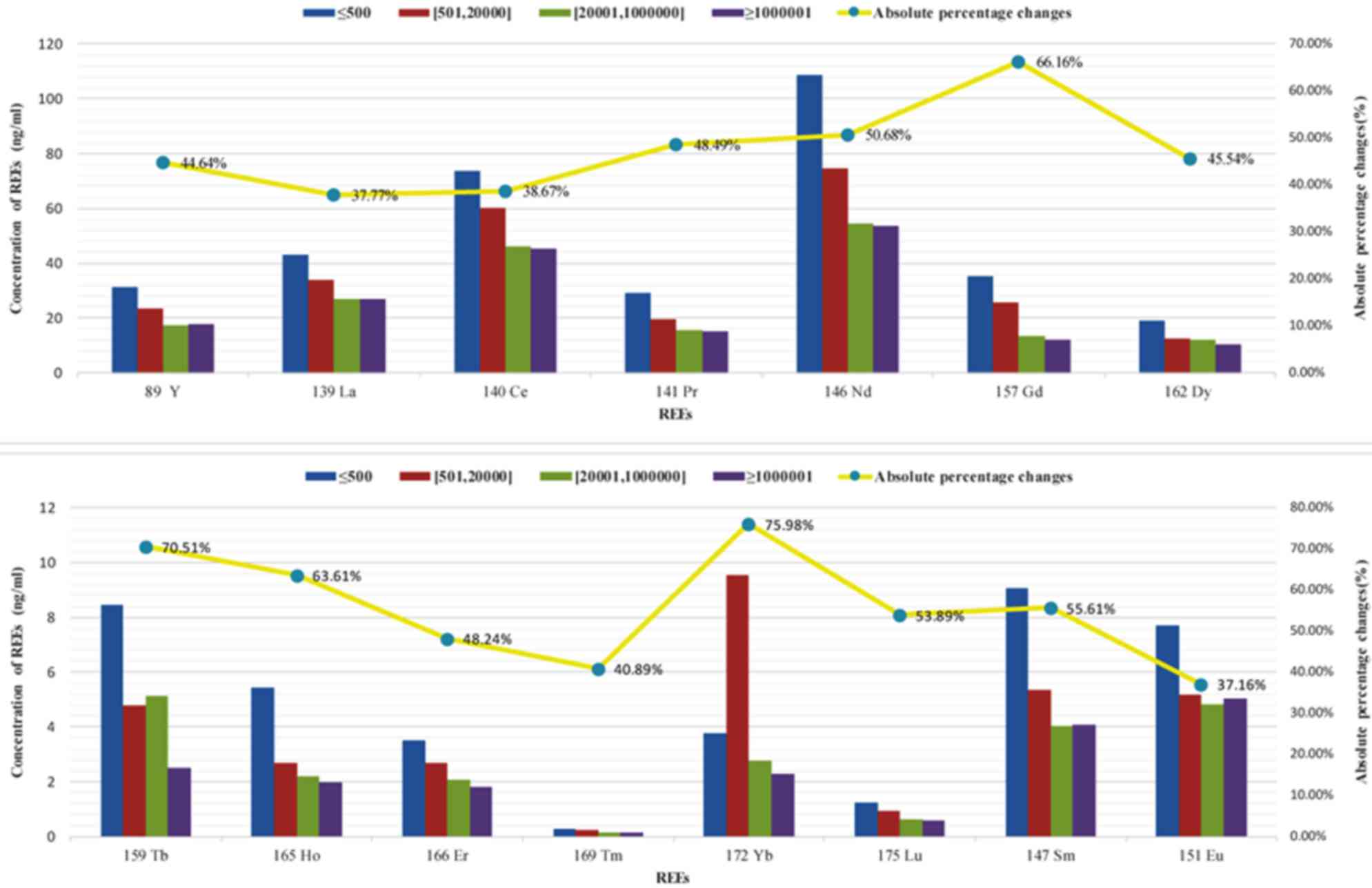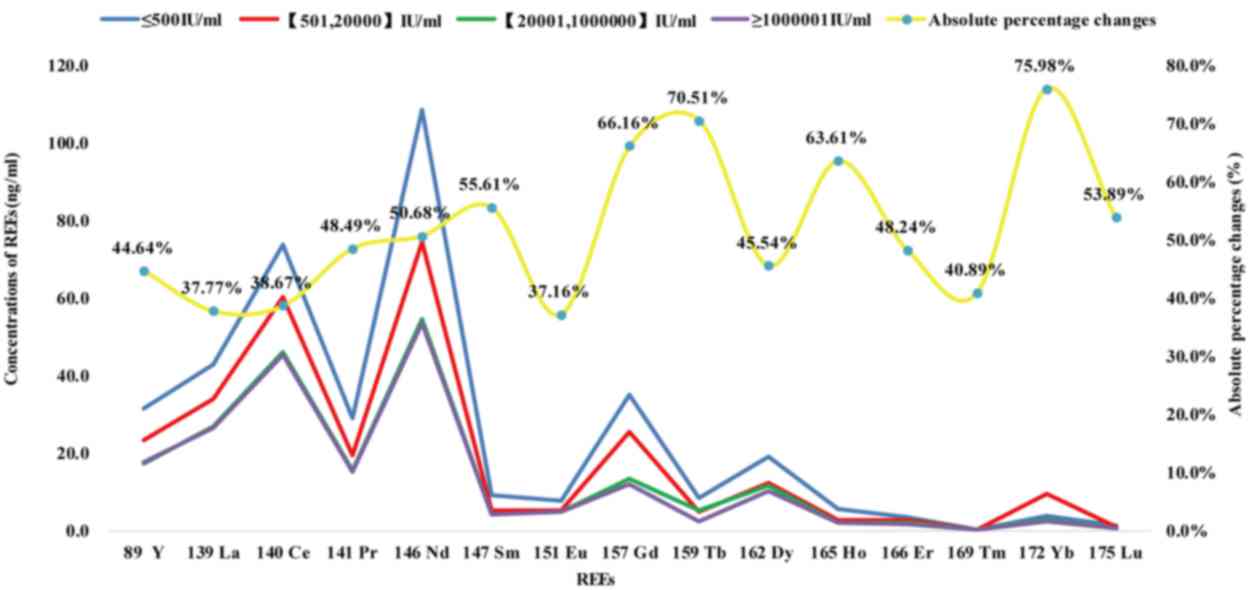|
1
|
Liu HP: A discussion of the development of
rare earth industry of Ganzhou. Nonferrous Metals Science and
Engineering. 101–104. 2012.(In Chinese).
|
|
2
|
Xu ST: Study on the problems and
countermeasures of Ganzhou sustainable development of rare earth
industry. J Jiangxi Univ Sci Technol. 47–51. 2014.(In Chinese).
|
|
3
|
Chen Z, Liu Y, Cheng W, Zhang L, Li H and
Wang Y: The environmental toxicology of rare earth elements
(147Pm, 141Ce, 147Nd) and their
safety elvaluation in environment. China Nuclear Sci Technol Rep.
33:2001.(In Chinese).
|
|
4
|
Ohnishi K, Usuda K, Nakayama S, Sugiura Y,
Kitamura Y, Kurita A, Tsuda Y, Kimura M and Kono K: Distribution,
elimination, and renal effects of single oral doses of europium in
rats. Biol Trace Elem Res. 143:1054–1063. 2011. View Article : Google Scholar : PubMed/NCBI
|
|
5
|
Guo ZY, Zhang YS and Zhang HJ: Pathway,
distribution, metabolism and toxicity of exogenous rare earth in
animals. Chin Rare Earths. 61–64. 1997.(In Chinese).
|
|
6
|
Schroeder HA and Mitchener M: Scandium,
chromium(VI), gallium, yttrium, rhodium, palladium, indium in mice:
Effects on growth and life span. J Nutr. 101:1431–1437. 1971.
View Article : Google Scholar : PubMed/NCBI
|
|
7
|
Smith JB and Smith L: Initiation of DNA
synthesis in quiescent Swiss 3T3 and 3T6 cells by lanthanum. Biosci
Rep. 4:777–782. 1984. View Article : Google Scholar : PubMed/NCBI
|
|
8
|
Lo YM, Chan LY, Lo KW, Leung SF, Zhang J,
Chan AT, Lee JC, Hjelm NM, Johnson PJ and Huang DP: Quantitative
analysis of cell-free Epstein-Barr virus DNA in plasma of patients
with nasopharyngeal carcinoma. Cancer Res. 59:1188–1191.
1999.PubMed/NCBI
|
|
9
|
Shotelersuk K, Khorprasert C, Sakdikul S,
Pornthanakasem W, Voravud N and Mutirangura A: Epstein-Barr virus
DNA in serum/plasma as a tumor marker for nasopharyngeal cancer.
Clin Cancer Res. 6:1046–1051. 2000.PubMed/NCBI
|
|
10
|
Sojka B, Kuricova M, Liskova A, Bartusova
M, Banski M, Misiewicz J, Dusinska M, Horvathova M, Jahnova E,
Ilavska S, et al: Hydrophobic sodium fluoride-based nanocrystals
doped with lanthanide ions: Assessment of in vitro toxicity to
human blood lymphocytes and phagocytes. J Appl Toxicol.
34:1220–1225. 2014. View
Article : Google Scholar : PubMed/NCBI
|
|
11
|
Pagano G, Guida M, Tommasi F and Oral R:
Health effects and toxicity mechanisms of rare earth
elements-Knowledge gaps and research prospects. Ecotoxicol Environ
Saf. 115:40–48. 2015. View Article : Google Scholar : PubMed/NCBI
|
|
12
|
Cao R, Huang XH and Zhou Q: Research on
Molecular Biomarker of Rare Earths Ions Ecotoxicity. System Sci
Comprehensive Studies Agriculture. 2007.
|
|
13
|
Fernando KC and Barritt GJ:
Characterisation of the divalent cation channels of the hepatocyte
plasma membrane receptor-activated Ca2+ inflow system using
lanthanide ions. Biochim Biophys Acta. 1268:97–106. 1995.
View Article : Google Scholar : PubMed/NCBI
|
|
14
|
Matsumoto Y and Komiyama M: DNA hydrolysis
by rare-earth metal ions. Nucleic Acids Symp Ser. 1–34. 1992.
|
|
15
|
Leuratti C, Singh R, Lagneau C, Farmer PB,
Plastaras JP, Marnett LJ and Shuker DE: Determination of
malondialdehyde-induced DNA damage in human tissues using an
immunoslot blot assay. Carcinogenesis. 19:1919–1924. 1998.
View Article : Google Scholar : PubMed/NCBI
|
|
16
|
Leuratti C, Singh R, Lagneau C, Farmer PB,
Plastaras JP, Marnett LJ and Shuker DE: Determination of
malondialdehyde-induced DNA damage in human tissues using an
immunoslot blot assay. Carcinogenesis. 19:1919–1924. 1998.
View Article : Google Scholar : PubMed/NCBI
|
|
17
|
Mittal S and Pandey AK: Cerium oxide
nanoparticles induced toxicity in human lung cells: Role of ROS
mediated DNA damage and apoptosis. Biomed Res Int. 2014:8919342014.
View Article : Google Scholar : PubMed/NCBI
|
|
18
|
Huang PJ, Vazin M, Matuszek Ż and Liu J: A
new heavy lanthanide-dependent DNAzyme displaying strong metal
cooperativity and unrescuable phosphorothioate effect. Nucleic
Acids Res. 43:461–469. 2015. View Article : Google Scholar : PubMed/NCBI
|
|
19
|
Lin WT, Huang PJ, Pautler R and Liu J: The
group trend of lanthanides binding to DNA and DNAzymes with a
complex but symmetric pattern. Chem Commun (Camb). 50:11859–11862.
2014. View Article : Google Scholar : PubMed/NCBI
|
|
20
|
Giri S, Karakoti A, Graham RP, Maguire JL,
Reilly CM, Seal S, Rattan R and Shridhar V: Nanoceria: A Rare-earth
nanoparticle as a novel Anti-angiogenic therapeutic agent in
ovarian cancer. PLoS One. 8:e545782013. View Article : Google Scholar : PubMed/NCBI
|
|
21
|
Su X, Zheng X and Ni J: Lanthanum citrate
induces anoikis of Hela cells. Cancer Lett. 285:200–209. 2009.
View Article : Google Scholar : PubMed/NCBI
|
|
22
|
Perri F, Della Vittoria Scarpati G,
Giuliano M, D'Aniello C, Gnoni A, Cavaliere C, Licchetta A and
Pisconti S: Epstein-Barr virus infection and nasopharyngeal
carcinoma: The other side of the coin. Anticancer Drugs.
26:1017–1025. 2015. View Article : Google Scholar : PubMed/NCBI
|
|
23
|
Lim CS, Goh SL, Kariapper L, Krishnan G,
Lim YY and Ng CC: Inclusion bodies of recombinant Epstein-Barr
virus capsid antigen p18 as potential immobilized antigens in
enzyme immunoassays for detection of nasopharyngeal carcinoma. Clin
Chim Acta. 448:206–210. 2015. View Article : Google Scholar : PubMed/NCBI
|
|
24
|
Mutirangura A, Pornthanakasem W,
Theamboonlers A, Sriuranpong V, Lertsanguansinchi P, Yenrudi S,
Voravud N, Supiyaphun P and Poovorawan Y: Epstein-Barr viral DNA in
serum of patients with nasopharyngeal carcinoma. Clin Cancer Res.
4:665–669. 1998.PubMed/NCBI
|
|
25
|
Xu J, Wan XB, Huang XF, Chan KC, Hong MH,
Wang LH, Long ZJ, Liu Q, Yan M, Lo YM, et al: Serologic antienzyme
rate of Epstein-Barr virus DNase-specific neutralizing antibody
segregates TNM classification in nasopharyngeal carcinoma. J Clin
Oncol. 28:5202–5209. 2010. View Article : Google Scholar : PubMed/NCBI
|
|
26
|
Li Y, Wang K, Yin SK, Zheng HL and Min DL:
Expression of Epstein-Barr virus antibodies EA-IgG, Rta-IgG, and
VCA-IgA in nasopharyngeal carcinoma and their use in a combined
diagnostic assay. Genet Mol Res. 15:2016.
|
|
27
|
Tiwawech D, Srivatanakul P, Karaluk A and
Ishida T: Significance of plasma IgA and IgG antibodies to
Epstein-Barr virus early and viral capsid antigens in Thai
nasopharyngeal carcinoma. Asian Pac J Cancer Prev. 4:113–118.
2003.PubMed/NCBI
|
|
28
|
Gourzones C, Gelin A, Bombik I, Klibi J,
Vérillaud B, Guigay J, Lang P, Témam S, Schneider V, Amiel C, et
al: Extra-cellular release and blood diffusion of BART viral
micro-RNAs produced by EBV-infected nasopharyngeal carcinoma cells.
Virol J. 7:2712010. View Article : Google Scholar : PubMed/NCBI
|
|
29
|
Yip TT, Ngan RK, Fong AH and Law SC:
Application of circulating plasma/serum EBV DNA in the clinical
management of nasopharyngeal carcinoma. Oral Oncol. 50:527–538.
2014. View Article : Google Scholar : PubMed/NCBI
|
|
30
|
Leung SF, Chan KC, Ma BB, Hui EP, Mo F,
Chow KC, Leung L, Chu KW, Zee B, Lo YM and Chan AT: Plasma
Epstein-Barr viral DNA load at midpoint of radiotherapy course
predicts outcome in advanced-stage nasopharyngeal carcinoma. Ann
Oncol. 25:1204–1208. 2014. View Article : Google Scholar : PubMed/NCBI
|
|
31
|
Tan CH: Epstein-Barr virus, chemical
carcinogens and nasopharyngeal carcinoma. Practical J Cancer.
58–59. 1992.(In Chinese).
|
|
32
|
Fang CY, Huang SY, Wu CC, Hsu HY, Chou SP,
Tsai CH, Chang Y, Takada K and Chen JY: The synergistic effect of
chemical carcinogens enhances Epstein-Barr virus reactivation and
tumor progression of nasopharyngeal carcinoma cells. PLoS One.
7:e448102012. View Article : Google Scholar : PubMed/NCBI
|
|
33
|
Fang CY, Lee CH, Wu CC, Chang YT, Yu SL,
Chou SP, Huang PT, Chen CL, Hou JW, Chang Y, et al: Recurrent
chemical reactivations of EBV promotes genome instability and
enhances tumor progression of nasopharyngeal carcinoma cells. Int J
Cancer. 124:2016–2025. 2009. View Article : Google Scholar : PubMed/NCBI
|
|
34
|
Bhakta-Guha D and Efferth T: Hormesis:
Decoding two sides of the same coin. Pharmaceuticals (Basel).
8:865–883. 2015. View Article : Google Scholar : PubMed/NCBI
|















